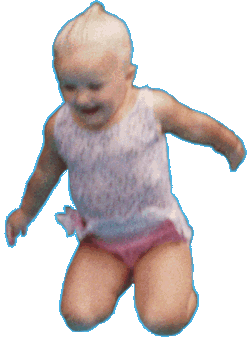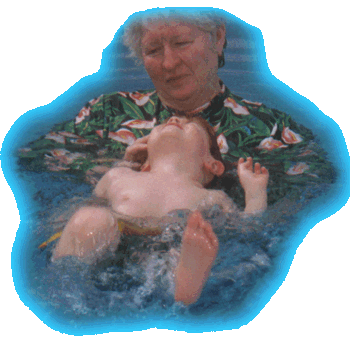|
We can start teaching your child to swim as young as one year old. It’s a great way to help insure their safety around water and give them a skill they can enjoy for a lifetime. —Linda Riggins
|
Beginning as Young as One Year Old

Linda starts toddlers swimming at about one year. She believes they need to be able to walk before they can move vertically in the water, as they will when they tread water. Once they can put their faces in the water, reach with their arms, and kick their legs, they’ll be ready to become prone and start paddling.
Flotation Devices Build Strength and Confidence
These flotation devices won’t support children fully like a life vest does, but they do provide enough buoyancy for children to learn skills while they become strong and confident enough to actually swim. Linda gradually removes the floats until the children are able to swim on their own.
Stroking Starts with a Strong Dog Paddle
Why? If your child falls into a pool, you won’t care whether or not her stroke is perfect: You’ll just want her to be able to survive until she can reach the side of the pool or you can help her. Linda begins by teaching children to tread water, dog paddle, and backstroke; then she moves on to perfecting their other strokes.
 Lots of Swimming
Lots of Swimming
During each ½-hour lesson, young children swim the 16-foot width of the pool 12 times. Once they’ve advanced, they swim the 34-foot length of the pool three times each lesson. With this much swimming, you can understand why they get so strong so fast.
Lessons End with "Play" Time
Linda calls it play, but the real purpose of this time at the end of every lesson is to help children learn to think on their own in the water. This is when they’ll learn to cope with a variety of situations (like accidental splashes), so that they can handle them in a play setting away from lessons.
 Instruction Tailored to Your Child
Instruction Tailored to Your Child
Each child is handled differently at Linda’s. From the first lesson, for example, the children jump off the side of the pool and the diving board. Many children just make the plunge, but others must be supported with a helping hand. The success they feel gives them the confidence to try again.
Handling Tears
If your child cries, it doesn’t mean he isn’t ready for swim lessons. He may be adjusting to the separation from Mom or Dad, getting accustomed to the new surroundings, or just having a bad day. If you give your child some time and let him see that you’re confident, he’ll follow your lead, relax, and enjoy this wonderful experience.
Questions? Comments? E-mail us at: swim@lindariggins.com

|




